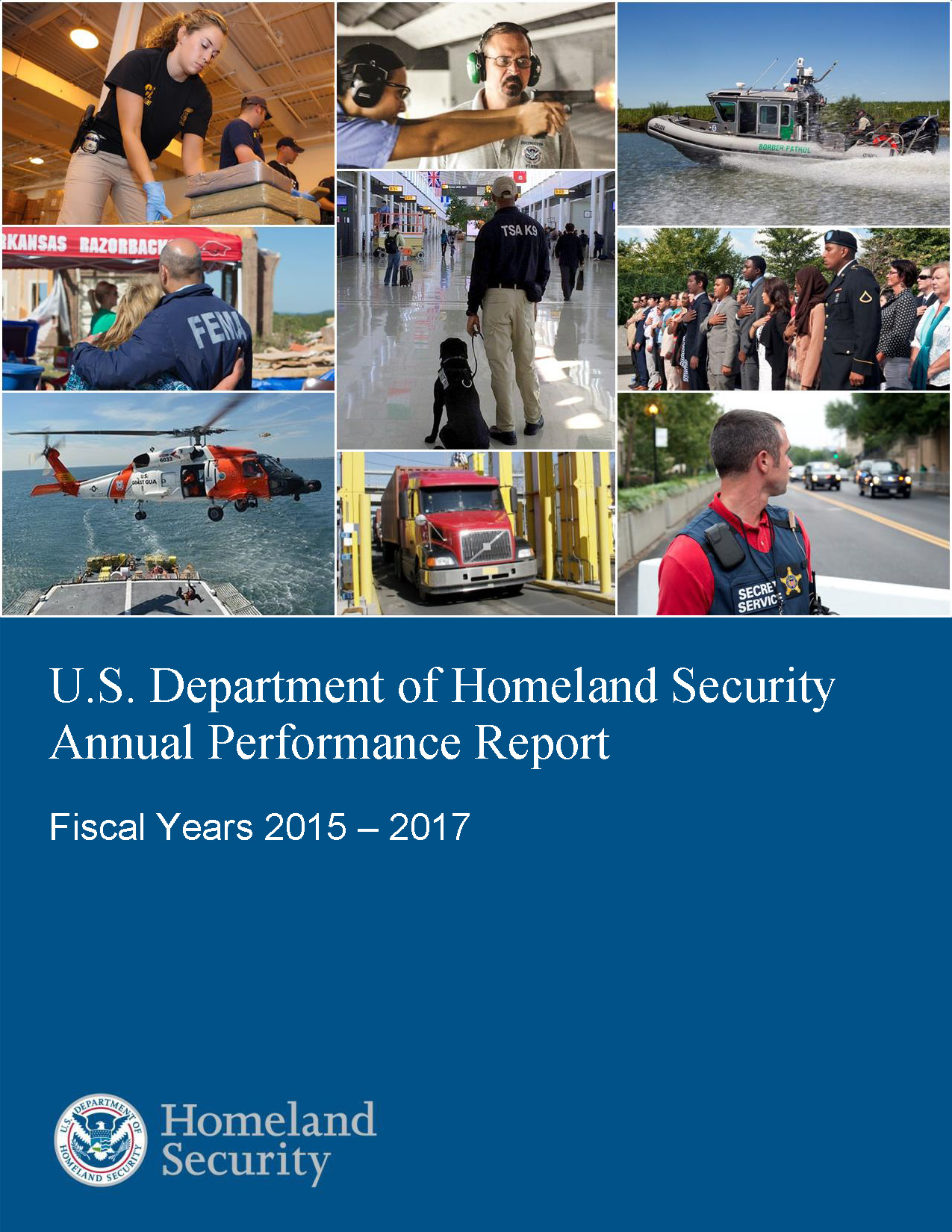- Home
- Agencies
- Department of Agriculture
- Department of Housing and Urban Development
- General Services Administration
- Department of Commerce
- Department of the Interior
- National Aeronautics and Space Administration
- Department of Defense
- Department of Justice
- National Science Foundation
- Department of Education
- Department of Labor
- Office of Personnel Management
- Department of Energy
- Department of State
- Small Business Administration
- Environmental Protection Agency
- Department of Transportation
- Social Security Administration
- Department of Health and Human Services
- Department of the Treasury
- U.S. Agency for International Development
- Department of Homeland Security
- Department of Veterans Affairs
- Goals
- Initiatives
- Programs
Primary tabs
FY 16-17: Agency Priority Goal
Enhance Disaster Preparedness and Response
Priority Goal
Goal Overview
FEMA continues to allocate resources to supplement whole community investment to prepare for the greatest challenge in emergency management—a catastrophic disaster. In order to successfully respond to and recover from a catastrophic event, the whole community, including FEMA, state and local governments, and individuals that may be affected, need to build and sustain capabilities and implement the National Preparedness System to achieve the National Preparedness Goal of a secure and resilient Nation.
In order to achieve this goal, FEMA has implemented activities and programs that assist in addressing gaps in state and local planning efforts, improved the governance, coordination structures, and guidance for managing the Agency’s incident workforce, and designed and delivered accessible information and tools to promote collective actions and empower grassroots problem solving.
Strategies
In order to build the Nation’s resilience to disasters of all types, including catastrophic disasters, FEMA is conducting preparedness activities to build and sustain capabilities with the greatest potential to change outcomes on the ground in catastrophic disasters, including the following:
1. FEMA is providing technical assistance to state, local, tribal, and territorial governments on improving the quality of their measurable THIRA targets and estimate the resources required to meet capability targets.
2. FEMA is working with state, local, tribal, and territorial governments to help identify and address gaps in the planning, organization, equipment, training, and exercises elements of each core capability, and states assess current capabilities through the State Preparedness Reports.
3. FEMA is standardizing the education and training of its workforce to enable the Agency’s incident workforce to rapidly mobilize and effectively deploy to meet the needs of disaster-affected communities.
4. FEMA is leading efforts to increase participation of private and non-profit organizations in the National Exercise Program to make the whole community better prepared and positioned to take actions in catastrophic events.
5. FEMA awards non-disaster grants to states and local jurisdictions to support the building, sustainment, and delivery of core capabilities to prepare the Nation for the threats and hazards that pose the greatest risk to the security and resilience of the United States. Grantees prioritize grant funding to address gaps in achieving capability targets set through the annual THIRA process.
Progress Update
• FEMA conducts an analysis of state, urban area, territory, and tribal Threat and Hazard Identification and Risk Assessment submissions to determine alignment to Comprehensive Preparedness Guide 201 Second Edition: Threat and Hazard Identification and Risk Assessment Guide. In FY16, forty-eight out of 56 states and territories met all steps of the guidance (85.7 percent). Ten states and territories performed better in FY16 as compared to FY15. This analysis prioritizes technical assistance provided to states and territories to help them improve their THIRA submission.
• The National Exercise Program continued to encourage participation by private and non-profit organizations, and other whole community partners. Thirteen exercises out of thirty-three involved substantive participation from private and non-profit organizations, for a 39 percent result this Quarter.
• FEMA analyzed results from staffing, training, and equipping readiness categories from the Cadre Operational Readiness and Deployability Status Report to assess whether the FEMA workforce is positioned to respond to all hazards. Quarter Three results represent an increase of four percent from Quarter Two (58 percent).
• FEMA continues to implement its Plan to Reduce Disaster Administrative Costs. Projects in the Plan that made progress this quarter include: moving disaster spend plan data into the Enterprise Data Warehouse and continuing progress on measures of disaster effectiveness. FEMA also briefed congressional stakeholders on its Plan to Reduce Disaster Administrative Costs this quarter.
• FEMA produced an Individual Assistance Shared Costs Programs video supporting Objective 2.5 (Improve efficiency and effectiveness of Individual Assistance programs). This video informs external emergency managers and Reservists of the programs FEMA shares costs with under the Individual Assistance, Individuals and Households Program. The video specifically covers Other Needs Assistance (ONA), Critical Needs Assistance (CNA) and Transitional Sheltering Assistance (TSA). The video explains the purpose of these programs, how and when they are implemented (as CNA and TSA are not implemented for every disaster, the State or Tribal government must request them) and provides a general overview of the eligibility requirements.
• All revised Individuals and Households Program (IHP) letters for disaster survivors have been implemented, starting with West Virginia Severe Storms, Flooding, Landslides, and Mudslides (DR-4273. The letters were written in plain language and revised to ensure content matches current FEMA policies, procedures, and doctrine. As a result, not only do the letter revisions contribute to providing clearer and more concise information to disaster survivors, it also supports an exponential cost savings to the government by reducing the use of printing and shipping materials. For example, the initial IHP packet sent to applicants has been reduced from 40 pages to 5 pages.
• On June 1, 2016, FEMA completed a Memorandum of Agreement with the U.S. Small Business Administration (SBA) for out-of-sequence declarations. This agreement facilitates SBA making a declaration under its own authority and providing loans to disaster survivors in instances when a state may be appealing its initial denial for a presidential declaration, allowing FEMA to directly address any potential duplication of benefits.
• FEMA successfully implemented Phase 1 of the Continued Temporary Housing Assistance (CTHA) improvement recommendations from the Office of Chief Counsel. Phase 1 consisted of developing a communication product, a procedural change, and a system modification to prevent unnecessary CTHA requests and redirect outreach for survivors who are most in need. Through this process FEMA is able to more efficiently triage CTHA requests and minimize unnecessary casework or handle-times for FEMA agents.
Next Steps
• In Quarter Four, FEMA will provide technical assistance to states, territories, tribes, and urban areas on the calendar year 2016 Threat and Hazard Identification and Risk Assessment/State Preparedness Report Unified Reporting Tool to help states and territories remediate identified issues.
• In Quarter Four, FEMA will finalize the analysis of calendar year 2015 Threat and Hazard Identification and Risk Assessment and State Preparedness Report data at the national level to identify trends in national preparedness.
• In Quarter Four, FEMA will offer national-level data on state capabilities to over 26 Federal agencies and 15 FEMA programs to help refine, develop, and implement preparedness programs and initiatives such as training, exercise, and planning support.
• In Quarter Four, FEMA will complete a review of the implementation of the Plan to Reduce Disaster Administrative Costs. FEMA will focus on improving its administrative cost reporting capabilities, and preparing for the November 30, 2016 Report to Congress on Disaster Administrative Costs, required by the Directing Dollars to Disaster Relief Act of 2015 signed into law on February 29, 2016.
• In Quarter Four, the Individuals and Households Program Unified Guidance will be published to provide FEMA employees, emergency management partners, political leadership, and the public with a single, comprehensive reference containing policy statements and eligibility criteria for all forms of Individuals and Households Program assistance. This guidance replaces existing stand-alone policies and provides State, Territory, and Indian Tribal Government officials a concise reference tool to assist with the needs of disaster survivors in their jurisdiction.
• In FY17, the measure “Operational readiness rating of FEMA’s specialized incident workforce cadres” will be revised to capture the input elements of readiness, emergency response staffing and position qualification.
Expand All
Performance Indicators
Percent of states and territories that have achieved an intermediate or above proficiency to address their targets established through their Threat and Hazard Identification and Risk Assessment
Percent of National Exercise Program (NEP) exercises demonstrating substantive whole community partnership and participation
Operational readiness rating of FEMA's specialized incident work force cadres
Average annual percentage of administrative costs for major disaster field operations, as compared to total program costs
Percent of FEMA Individual Assistance services that are delivered in a timely, effective and efficient manner
Contributing Programs & Other Factors
- The National Preparedness Program works to ensure that the Nation is prepared for disasters of all kinds. This program houses management and administrative support functions associated with training and national exercise programs funded through the State and Local Programs appropriation.
- The National Continuity Program carries out a mandated mission to provide Executive Agent leadership to guarantee the survival of an enduring Constitutional government by ensuring continuity of national operations in response to national emergencies. FEMA maintains an appropriately resourced, staffed, and equipped ability to provide Executive Leadership for Continuity of Government. Continuity of Operations, and national contingency programs.
- The Response programs provide the core Federal response capability to save lives and protect property in communities throughout the
- Nation that have been overwhelmed by the impact of a major disaster or an emergency. Response operations ensures that Federal disaster response systems and capabilities are properly positioned to support Federal decision-makers and enable them to immediately receive and react to the requirements needed to support states that have been overwhelmed by the demands of an emergency or major disaster.
- The Recovery program ensures that individuals and communities affected by disasters of all sizes, including catastrophic and terrorist events, return to normal function with minimal suffering and disruption of services through Individual Assistance and Public Assistance. Through the Recovery program, FEMA takes the lead among Federal agencies, state and local governments, and representatives of non-governmental organizations to support communities in rebuilding, enabling individuals, civic institutions, businesses, and governmental organizations to function on their own, return to normal life, and protect against future hazards.
- The Federal Insurance and Mitigation Administration manages the National Flood Insurance Program within FEMA, along with a range of programs designed to reduce future losses to homes, businesses, schools, public buildings, and critical facilities from floods, earthquakes, tornadoes, and other natural disasters.
- The FEMA regions provide technical assistance to the state, local, tribal, and territorial governments for implementation of the National Preparedness System.
- States and territories are required to submit annual THIRAs and SPRs assessing their capability to implement the core capabilities described in the National Preparedness Goal.
No Data Available










